10 Worst Modifications for Students with Disabilities (and 100+ Good Ones!)
September 29, 2015
Good modifications are a wonderful way to support your students with disabilities so they can experience everything the general curriculum has to offer. But bad modifications–at best, they don’t help, and at worst, they can do more harm than good.
So how do you know the difference?
Before we get to that, here’s a quick refresher on the difference between modifications and accommodations, in case you’d like a clearer definition. Our friend Nicole Eredics at The Inclusive Class came up with this elegant little chart that summarizes the differences really well; with her permission, I’m including it here:
To summarize the difference, here’s a quote from Understood.org: “Accommodations change how a student learns the material. A modification changes what a student is taught or expected to learn.” Both happen within the general education classroom, but an IEP team might choose modifications to make the curriculum accessible and appropriate for a student with more significant learning needs.
When modifications are chosen over accommodations, sometimes there’s confusion about what types of alterations should be made to best help the student succeed. Let’s look at some examples. In The Speech-Language Pathologist’s Handbook for Inclusive School Practices, Julie Causton and Chelsea Tracy-Bronson list the top 10 worst types of classroom modifications for students with disabilities. (They count them down from 10 to 1 like Letterman used to, but this top 10 is definitely the opposite of funny.)
Here’s their list of examples:
10. The seventh grade class is doing math, but one student is using Sesame Street blocks to work on counting.
9. The class is watching a video, but one student who is blind is sent out of the room because she can’t see.
8. The classroom is arranged with desks in groups of five, but one student is seated in a group with only two desks, one for him and one for his assistant.
7. While the rest of the high school class is doing reports on nutrition, one student is given a tub of dry beans and rice to “explore.”
6. Fourth-grade students are adding adjectives to sentences, but because the SLP has not yet put adjectives on one student’s communication board, the student does not participate in this lesson.
5. During silent reading, the SLP takes one student to the back of the classroom to work on articulation.
4. Because one student has dressing goals on her individualized education program, she puts on and takes off her shoes two times when she gets ready for gym class.
3. Because one student does not yet read, she listens to a music tape while the teacher reads aloud to the class.
2. A student who types to communicate is provided with a device only during language arts class.
1. A 12-year-old student goes with the second-grade class to physical education because his gross motor skills are “at that level.”
You can see what’s going on in these examples. Age-inappropriate materials that may embarrass a student and affect the way her peers perceive her. Classroom arrangements and schedules that physically divide a student from his same-age peers. “Modifications” that don’t have much to do with the lesson and don’t presume a student’s competence.
So how do we choose good modifications?
You’ll know a modification is good when it helps your student participate meaningfully and productively in class. Good modifications focus on a student’s individual strengths and needs, use age-appropriate materials, are relevant to the content everyone else is learning, and reflect a culture of high expectations. Causton and Tracy-Bronson share some solid modification ideas in their book–maybe you’ve tried some of these already in your own classroom.
(Please note that this list doesn’t provide direct, 1:1 alternatives to the “worst modifications” above—these are just a few options for helping students access the curriculum, and they won’t work for every learner. Your students will have a broad range of skills and abilities, and the modifications you choose should always be personalized to their specific strengths and needs.)
- Reword test items using simplified language.
- Reduce the number of problems or questions on a test.
- Provide a topic bag filled with a variety of interesting objects that directly relate to the content.
- Modify a worksheet with easier-to-read numbers and allow use of a calculator.
- Present picture communication symbol choices on tests.
- Allow spelling support from a spell-check program.
- Have a student create an outline instead of an essay.
- Provide a word bank of choices on a test.
- Have a peer summarize a reading assignment for a student who needs support (be careful not to call on the same peer to help every time–mix it up, and you’ll benefit everyone).
Want more ideas to add to your toolbox? In today’s download, you’ll get 100+ quick tips for modifications, adaptations, and accommodations. You’ll find a list of content-specific ideas for different subjects–math, reading, science, art, and more–and a list of supports for everyday activities, including test-taking, giving oral presentations, and getting organized. Print it and keep it handy (and share with your favorite teacher, too)!
Download 100+ bright ideas for modifying content and activities!
New to the Brookes Inclusion Lab? Keep reading—check out our archive of Inclusion 411 posts, packed with practical tips and free downloads!
Read more posts and get more infographics inspired by Julie Causton’s books:
11 tips for new inclusive educators
6 student engagement tips

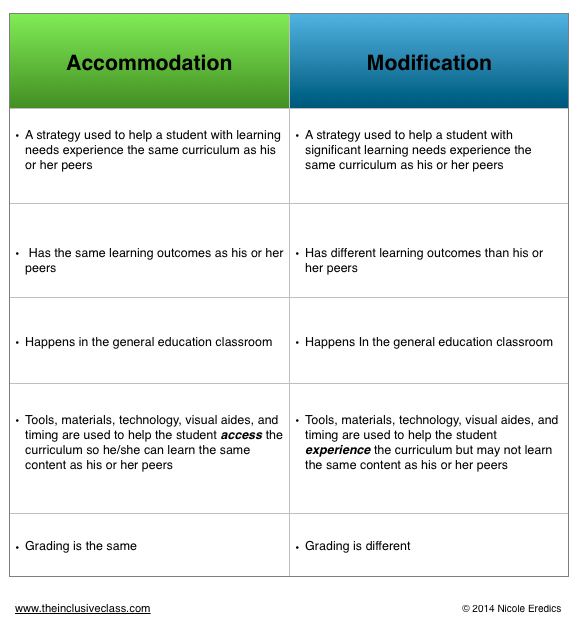
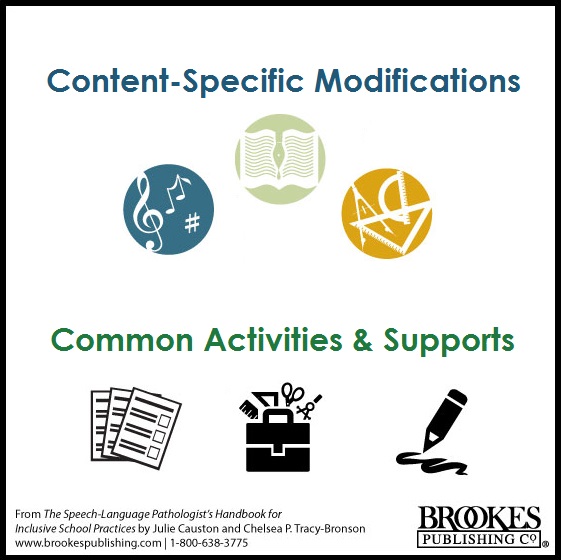
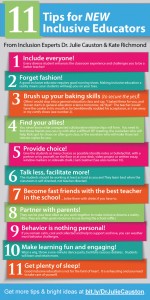
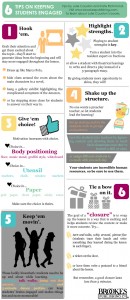


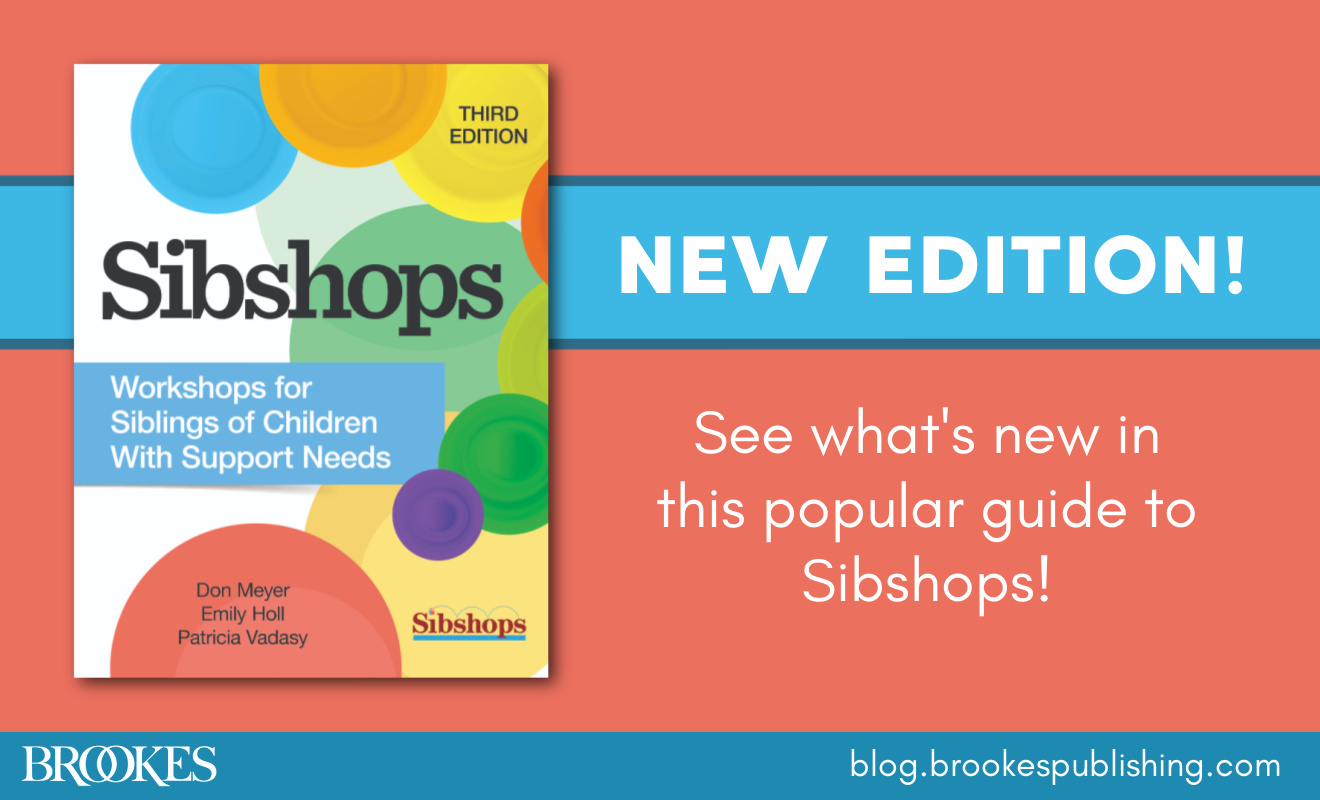
Write a Comment
Your email address will not be published. Required fields are marked *
comments
Deb Derro says
I'm disappointed in the comparison between the modifications qualified as good and bad. I think it is quite obvious that the "bad" list shows very inappropriate examples for any child; however, the list of "good"examples does not refer to a child with similar strengths and needs. Looking at the "bad" list, it refers to students who need sensory input from a container with beans, are at a developmental level where using blocks to learn 1:1 correspondence is appropriate, and one student is learning how to don and doff his shoes. In contrast, the "good" list refers to students who are able to take a written test but require simplified language, create an outline, and use a word bank to complete an assignment. Please be sure that when lists such as this are published, they can be of use to both parents and teachers by making comparisons that make sense.
Post a Comment